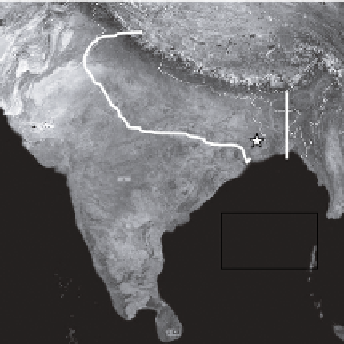Geoscience Reference
In-Depth Information
Himalaya
1
32
30
28
26
24
1
Thar
Deser
2
3
4
5
6
IGB
7
68 70 72 74 76 78 80 82 84 86 88
90 Longitude (E)
Arabian
Sea
Bay of
Bengal
SriLanka
Fig. 1. The IGB in the northern India with the locations of major urban areas, as
indicated by (1) Delhi, (2) Agra, (3) Kanpur, (4) Allahabad, (5) Varanasi, (6) Patna,
and (7) Kolkata.
The Indo-Gangetic basin (IGB) in India (Fig. 1) is a region, where
anthropogenic and natural aerosols have changing pattern in their loadings
in different seasons.
5
−
7
In terms of aerosol loading, despite being one of the
most polluted regions in the world,
8
−
12
the spatio-temporal distribution
of ADRF in the IGB is poorly understood. Most of the previous studies
are limited in spatial and temporal scale, e.g. Dey and Tripathi
12
and
Tripathi
et al.
9
have studied the aerosol and BC radiative effects in
Kanpur (Fig. 1) during the winter months (December-February) based on
the direct measurements of aerosol parameters during a land campaign
conducted by Indian Space Research Organization in December 2004-
January 2005.
11
,
13
Aerosol DRF estimation have been carried out for
Delhi,
14
Hissar (semi-urban site in IGB),
15
and Nainital (high altitude site
in the Himalaya),
16
but only for wintertime. Ramanathan and Ramana
8
have also investigated the climatic impact of absorbing haze over the
IGB during the dry months (October-May). During the pre-monsoon
(March-May) dust loading season, ADRF estimation has been carried out
only for Kanpur
7
and Delhi
17
regions. All these studies indicated a very
high magnitude of surface cooling (i.e. solar dimming) and atmospheric
absorption (heating effect) over the respective locations, which has adverse
effect on the regional climate. But how much of it is the anthropogenic
fraction is not known, neither its spatio-temporal variability. Here, we
report the spatio-temporal variations of the anthropogenic contribution to











